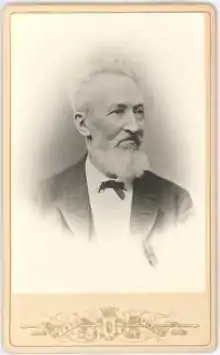Carl Schmidt (chemist)
Carl Ernst Heinrich Schmidt (13 June [O.S. 1] 1822 – 11 March [O.S. 27] 1894), also known in Russia as Karl Genrikhovich Schmidt (Russian: Карл Ге́нрихович Шмидт, romanized: Karl Génrichovič Šmidt) was a Baltic German chemist from the Governorate of Livonia, a part of the Russian Empire. He determined the typical crystallization patterns of many important biochemicals such as uric acid, oxalic acid and its salts, lactic acid, cholesterin, stearin, etc.
Carl Schmidt | |
|---|---|
 Carl Schmidt | |
| Born | 13 June [O.S. 1] 1822 |
| Died | 11 March [O.S. 27] 1894 (aged 71) Dorpat, Kreis Dorpat, Governorate of Livonia, Russian Empire (present-day Tartu, Tartu County, Estonia) |
| Nationality | Baltic German |
| Alma mater | Ludwig University of Gießen Georg August University of Göttingen |
| Scientific career | |
| Fields | Chemistry |
| Institutions | Imperial University of Dorpat |
| Doctoral advisor | Justus von Liebig (Chemistry) Friedrich Wöhler (Medicine) |
| Doctoral students | Wilhelm Ostwald Gustav Tammann |
Schmidt analyzed muscle fiber and chitin. He showed that animal and plant cell constituents are chemically similar and studied reactions of calcium albuminates. He studied alcoholic fermentation and the chemistry of metabolism and digestion. He discovered hydrochloric acid in gastric juice and its chemical interaction with pepsin. He studied bile and pancreatic juices. Some of this work was done with Friedrich Bidder. He studied chemical changes in blood associated with cholera, dysentery, diabetes, and arsenic poisoning.
Schmidt received his PhD in 1844 from the University of Gießen under Justus von Liebig. In 1845, he first announced the presence in the test of some Ascidians of what he called "tunicine", a substance very similar to cellulose. Tunicine now is regarded as cellulose and correspondingly a remarkable substance to find in an animal.[1][2]
In 1850, Schmidt had been named Professor of Pharmacy at Dorpat (Tartu) and in 1851 he was appointed Professor of Chemistry in the mathematical and physical division on the University of Dorpat. He was a corresponding member (1873) of the Saint Petersburg Academy of Sciences (today Russian Academy of Sciences). He was the president of the Estonian Naturalists' Society in 1894. Schmidt is notable as the PhD advisor of the Nobel Prize winner Wilhelm Ostwald.
Notes
- Harmer, Sir Sidney Frederic; Shipley, Arthur Everett et alia: The Cambridge natural history Volume 7, Hemichordata, Ascidians, Amphioxus and Fishes Macmillan Company 1904
- Hall, D. A. Saxl, Hedwig. Studies of Human and Tunicate Cellulose and of their Relation to Reticulin. Proc. R. Soc. Lond. B 1961 155, 202-217 doi:10.1098/rspb.1961.0066
References
- J.R. Partington, A History of Chemistry, Macmillan, 1964, vol. 4, p. 306 and p. 595.
- Dictionary of Scientific Biography, Charles Scribner's Sons, 1970–1990, vol. 2, p. 124a.
- St. Szcz Zaleski (1894). "Carl Schmidt". Chem. Ber. 27 (4): 963–978. doi:10.1002/cber.18940270494.
- R. Stefan Ross (2005). "Carl Schmidt – a chemical tourist in Victorian Britain". Endeavour. 29 (1): 33–37. doi:10.1016/j.endeavour.2005.01.006. PMID 15749151.
- Physiological-Chemical Research of Bidder and Schmidt
- Official site of Russian Academy of Sciences. Information about Carl Schmidt